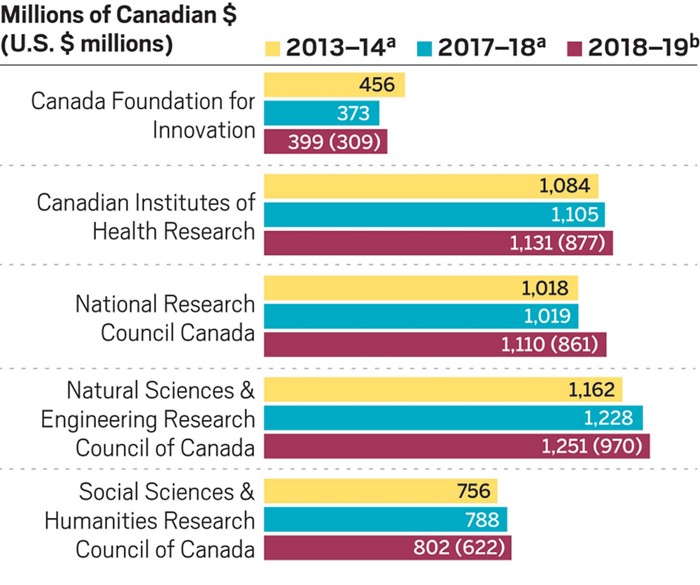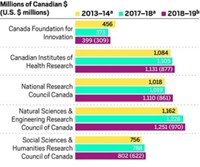Advertisement
Grab your lab coat. Let's get started
Welcome!
Welcome!
Create an account below to get 6 C&EN articles per month, receive newsletters and more - all free.
It seems this is your first time logging in online. Please enter the following information to continue.
As an ACS member you automatically get access to this site. All we need is few more details to create your reading experience.
Not you? Sign in with a different account.
Not you? Sign in with a different account.
ERROR 1
ERROR 1
ERROR 2
ERROR 2
ERROR 2
ERROR 2
ERROR 2
Password and Confirm password must match.
If you have an ACS member number, please enter it here so we can link this account to your membership. (optional)
ERROR 2
ACS values your privacy. By submitting your information, you are gaining access to C&EN and subscribing to our weekly newsletter. We use the information you provide to make your reading experience better, and we will never sell your data to third party members.
Research Funding
Canada recommits to basic science
Trudeau government proposes to add 4 billion Canadian dollars over five years for research programs
by Sharon Oosthoek , special to C&EN
March 30, 2018
| A version of this story appeared in
Volume 96, Issue 14

Prime Minister Trudeau proposes to increase basic research funding starting in 2018–19. Total science and technology funding across the Canadian government was $11.3 billion in 2017–18.
a Actual, converted for inflation to 2018 dollars using Bank of Canada calculator on March 8.
b Proposed; figures converted from Canadian to U.S. dollars at the March 8 exchange rate of $1.00 Canadian = $0.78 U.S.
Sources: Statistics Canada, Government of Canada Budget Plan 2018
Canada is on track for a significant investment in science and research, according to the federal budget proposal announced Feb. 27. Prime Minister Justin Trudeau’s government plans to commit an additional 4 billion Canadian dollars (3.1 billion U.S. dollars) for research programs over the next five years.
Of that $4 billion, $925 million is earmarked for the country’s three main research-granting councils in what the government says is “the single largest investment in fundamental research in Canadian history.” The Natural Sciences & Engineering Research Council, Canadian Institutes of Health Research, and Social Sciences & Humanities Research Council will each get a 25% boost in funding phased in over three years, after which their funding will stabilize.
The budget also calls for stable funding for the Canada Foundation for Innovation (CFI), which pays for equipment and facilities at institutions across the country. CFI funding has fluctuated since it was established in 1997. The plan now is to more than double CFI’s budget over the next five years, then stabilize it.
The 2018 budget’s focus on research responds to last year’s government-commissioned Fundamental Science Review report, which recommended an increase of $1.3 billion in annual funding for the granting councils and CFI to make up for years of underspending relative to other countries. The report, led by former University of Toronto president C. David Naylor, highlighted a growing shortfall in science funding after cuts under previous prime minister Stephen Harper’s Conservative government.
While the announced boost to science doesn’t meet the $1.3 billion-per-year threshold, the budget makes “important advances on the road map developed by the Naylor report,” says Paul Davidson, president of Universities Canada, which advocates for Canadian universities.
Kathleen Walsh, director of policy at Evidence for Democracy, calls the budget a historic investment in fundamental research in Canada. She also lauds the government’s proposal to create a new tri-council fund to support research that is “international, interdisciplinary, fast breaking, and higher risk.”
In addition to increased funding for the granting councils and CFI, the 2018 budget announced a “reimagined” National Research Council (NRC), Canada’s federal research and development organization, which focused largely on commercial research under the Harper government. NRC’s new mission will be to “catalyze transformative, high-risk, high-reward research with the potential for game-changing scientific discoveries and technological breakthroughs,” the government says. That new mission, however, does not mean a large increase in NRC’s budget, which is slated for a 10% increase to $1.1 billion in 2018–19 and would be stagnant after that.
The budget also changes the government’s previous focus on large grants for “boutique” research, in which a small number of senior researchers head big projects. The overall goal is to allow for greater diversity among grant recipients.
“By my calculations, there was significantly less spent on specific projects this year compared to last year,” Walsh says. Canada’s 2017 budget, for example, included renewed funding of $6 million in 2017–18 for the Stem Cell Network. The network does not get a separate line item in the new proposed budget.
Advertisement
University of Ottawa ecologist Jeremy Kerr, who has spoken publicly about the need to fund early-career researchers, says he was especially pleased to see the federal government dedicate an additional $210 million over five years for the Canada Research Chairs Program. That program aims to attract younger scientists to and retain them in Canada.
“The government expects these newly appointed early-career researchers will be diverse. They’ve written this into the budget,” Kerr says. “It’s a really important message to move the previous status quo, which disproportionately saw these chairs going to men, and not very diverse men.”
Although the fiscal year starts on April 1, the Canadian Parliament typically passes a temporary spending measure to cover the first few months, then completes budget appropriations in June.



Join the conversation
Contact the reporter
Submit a Letter to the Editor for publication
Engage with us on Twitter